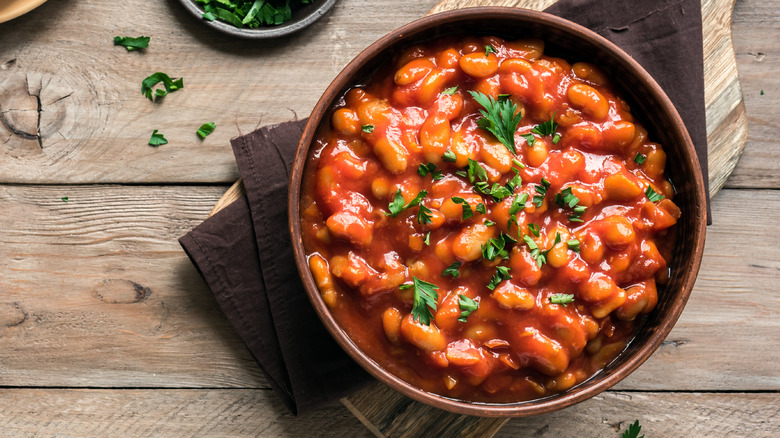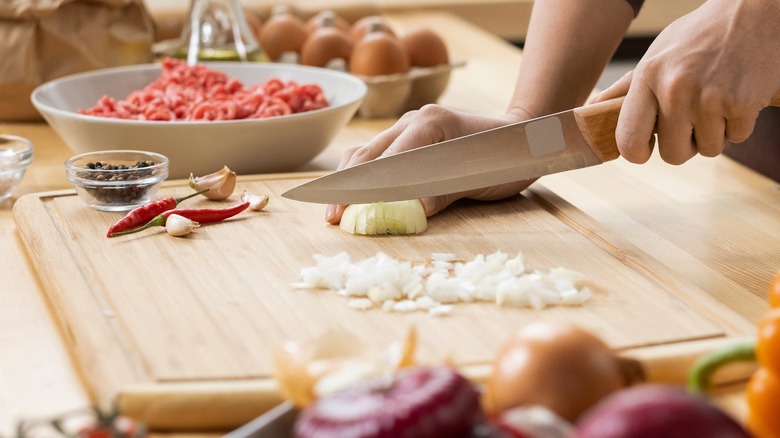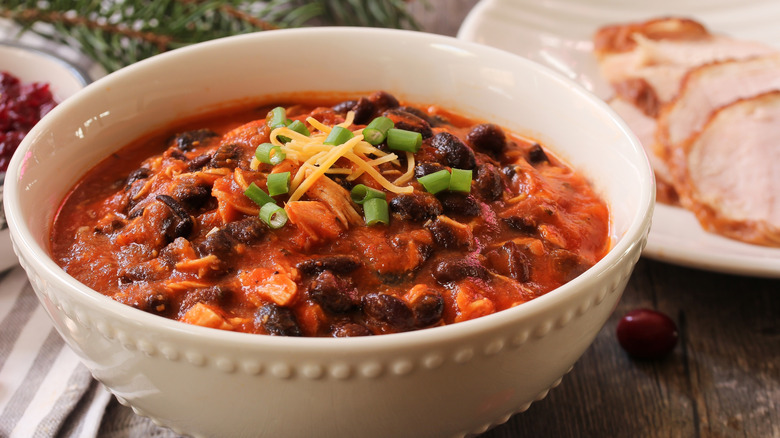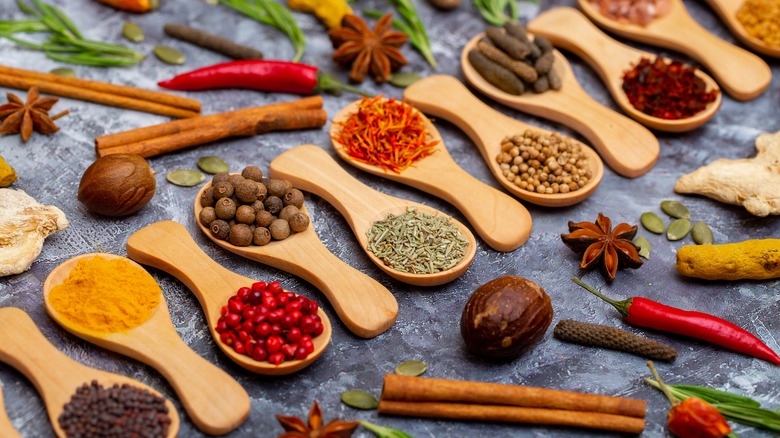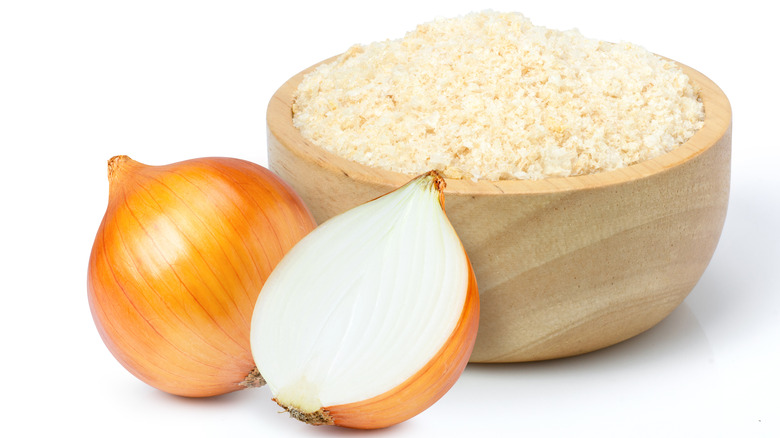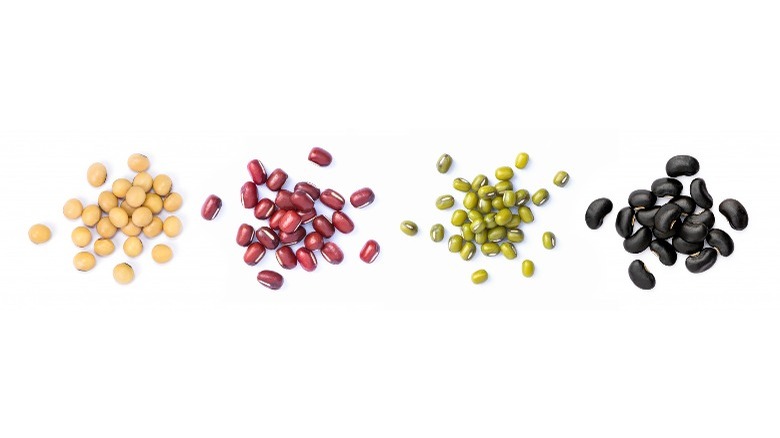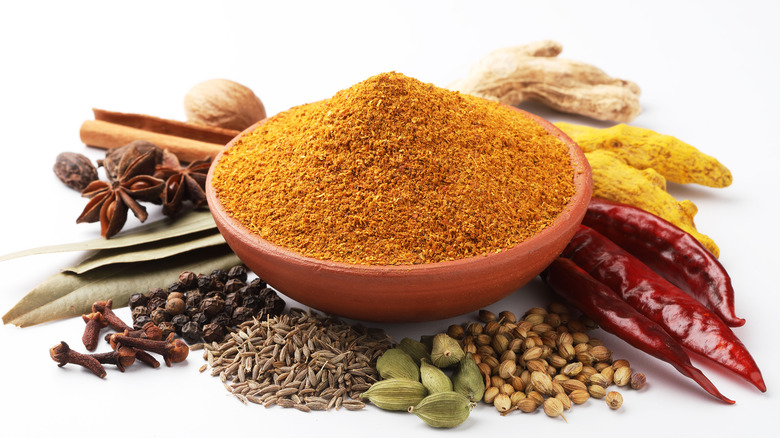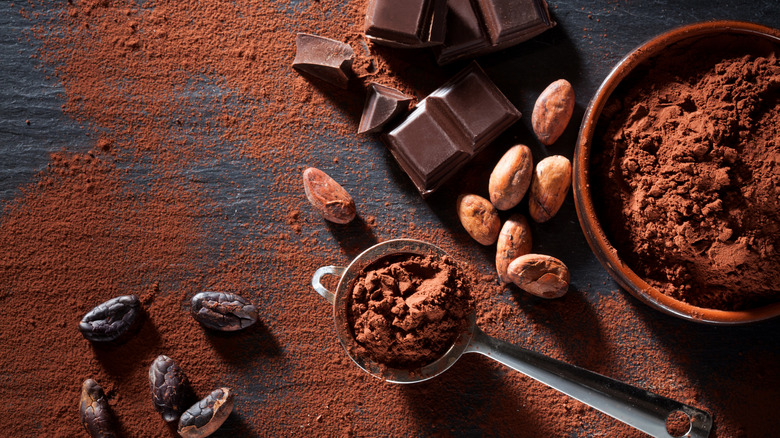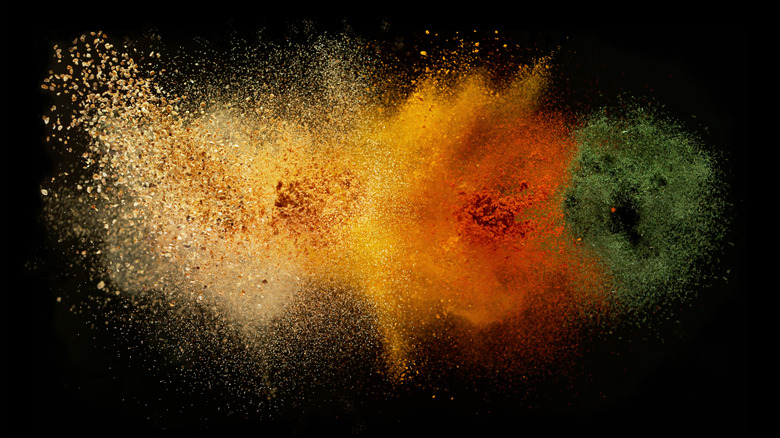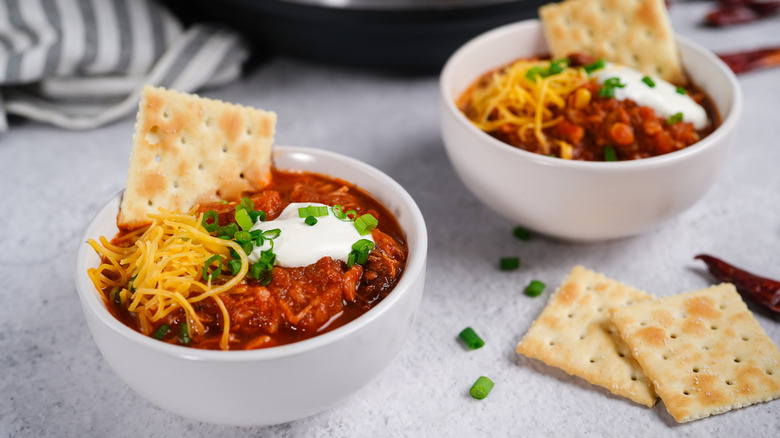11 Mistakes You're Making With Homemade Chili
Few things are more satisfying when the weather cools down than a heaping bowl of chili. This hearty meal can come in many forms, from the classic chili con carne (or chili with meat) to white chicken chili or vegetarian chili. Whatever your preference for chili style, making a pot is serious business, with chili societies and competitions popping up all over.
Despite chili's popularity, no one is entirely sure of its true origin. According to National Chili Day (which, by the way, is the fourth Thursday in February), one far-fetched origin story includes a Spanish nun in the 1600s. It's said that she had an out-of-body experience and brought back the first recipe for chili con carne. However, the most commonly accepted first recipe for chili comes from J.C. Clopper in 1828. After taking a trip to San Antonio, he described a mash comprised of meat, peppers, and onions made by the local residents to help make meat go further with each meal. Whatever the history, you do not want to make these common mistakes the next time you sit down to cook a pot of chili.
1. Overcooking the onions
What started off as a joke in the NBC sitcom "The Office" turns out to be incredibly good advice when it comes to making chili. Brian Baumgartner, who played Kevin Malone, gave one of the stand-out performances when the character makes a pot of his famous chili before promptly dropping it in the middle of the office lobby. During the scene, the character states that one of the secrets to great chili is to undercook the onions.
Baumgartner has since gone on to become a chili connoisseur himself, judging the World Chili Championship Cook-off, and even writing a chili cookbook himself, "Seriously Good Chili." In an interview with Mashed, he explains that when you cook the onions too long, they caramelize. Caramelized onions are delicious, but they have a distinct flavor that is not optimal for most chili. So instead, Baumgartner says to cook them just long enough to become translucent but not to begin to brown or burn. And for those who want Kevin's famous chili, all you have to do is look at the terms and conditions for Peacock.
2. Adding everything all at once
It can be tempting to add all the ingredients at once to a pot of chili. They are all being cooked together anyway, so why should it matter when all the ingredients are added? Well, it makes a big difference, and it turns out that adding all the ingredients at once is a surefire way to end up with a lackluster chili.
According to Recipe Tips, sautéing the vegetables before adding them can help both to soften them and release flavor. Onions, in particular, should be cooked before being added to the soup base to ensure they are not too hard. Just do not overcook them.
Additionally, browning the meat is crucial to bringing out the flavors. As Australian Beef explains, when you brown the beef first, it produces what is known as the Maillard reaction, which is when the meat undergoes a chemical change as it cooks, which releases new flavors. However, when meat is cooked in a liquid, such as a chili base, no Maillard reaction can occur and the meat will lack flavor.
Finally, Brian Baumgartner recommends adding the tomato paste part of the way through the meat cooking process if you are making traditional meat and tomato-based chili. This staggered addition will help bring all the flavors together cohesively.
3. Not letting it rest
All good things come to those who can wait, or so the saying goes. Well, with chili this is absolutely the case. Letting chili sit helps bring the flavors together, which is why making chili in the crockpot is so great. And the longer the ingredients sit together, the better. If you have the time to wait, some people on Reddit have noticed that soup is one of those foods that actually taste better as leftovers.
A spokesperson for The Institute of Food Technologies, Dr. Kantha Shelke, explains to Forbes that certain foods undergo chemical reactions that release flavor. When they are cooked, cooled, and then reheated, these chemical reactions can happen again and cause an increase in their flavors. The specific ingredients listed include those that are aromatic and flavor-focused, such as onions, peppers, garlic, and herbs — all critical elements for making chili.
Additionally, Alton Brown explains that allowing meat-based stews to cool before reheating can actually help the meat cook more evenly without falling apart. If you have the time, it is worth it to wait for your chili.
4. Using old spices
Everyone has spices that have been sitting on the shelf for who knows how long. Before you think about reaching for them, though, read on. While, according to spice producer McCormick, spices do not technically go bad, it is not recommended that you use them past their expiration date. This is because as spices age, they lose their potency. As McCormick notes, jarred spices typically only last one to two years to achieve optimal performance. However, Healthline reports that this can be a little longer for spices left in their whole form.
Cleaning out and replenishing a spice cabinet is an investment, but it is worth doing before making your next batch of chili to guarantee the best bowl possible. If you do not think you will use large quantities of spices, you can always buy small jars to minimize waste.
Plus, as Healthline points out, using spices and herbs in cooking can also have health benefits. One could argue that a finely spiced chili is both good and good for you.
5. Using dried instead of fresh
There is undoubtedly a place for dried spices in chili. Where would this savory, hearty bowl be without the burst of flavors and aromas given to it by the plethora of spices? However, there are some ingredients that just have to be added fresh for the chili to succeed.
The first is garlic. According to Websteraunt, dried granulated garlic is made from fresh garlic but produces a slightly different flavor. Whereas fresh garlic is somewhat sweet and offers a mild garlicky flavor, granulated garlic comes at full potency. This makes garlic powder ideal for things like garlic bread or other herb mixes, but it could quickly become overpowering for a soup.
Additionally, onions are a key ingredient in chili. Not only do they add flavor, but they add texture as well. Substituting real onions for onion powder could easily throw off not only the flavor but also the consistency of the chili, and nobody wants that.
Finally, if a recipe calls for fresh chilies, there is a hot reason not to substitute a dried product. As Chili World points out, the drying process often makes chilies spicier than they were when fresh, which means you could end up with a bowl of chili that is functionally inedible. Additionally, fresh chilies are better as a flavor enhancer, giving the chili a more rounded character.
6. Omitting beans
This may be a controversial stance but we stand by it. Omitting beans makes for less interesting chili that is simply lacking and feels unfinished. According to the World Championship Chili Cook-Off, beans are absolutely required if you make a homestyle chili because they give it depth. Beans also provide a heaping serving of fiber (via Healthline). Adding legumes to chili adds bulk and heartiness without relying on meat. In fact, there are chilis that omit meat entirely in favor of beans. In addition, when cooked in chili, they can be puréed into the base to make it thicker and richer and provide an almost creamy mouth feel.
When it comes to what type of beans to use, Randall Beans recommends sticking with the tried and true kidney bean. The company explains that this variety is incredibly hearty and holds up well under a lot of cooking. Additionally, the beans take on the flavor of the spices they are cooked in, allowing them to meld beautifully with the rest of the pot and give you the best chili possible.
7. Adding all the seasoning at once
As with other ingredients, it is important not to just dump everything in and hope for the best. Seasoning takes time. Celebrity chef and former NFL star Eddie Jackson explains to Mashed, "You got to season everything in levels." He elaborates that many people feel they just need to add items like salt once, and then they are done; but this is not the case. Seasoning at every step of the cooking process builds flavors and depth to the dish. He recommends that any time something is added to the pan, or in the case of a chili pot, at least a pinch of salt should be added to help season appropriately.
The Washington Post reports that chili champions agree with this thinking, saying most chili competitors add spices "in two or three dumps." Chili relies so heavily on spices and flavor that it would be a shame to throw everything in at once and prevent them from building on one another. With this method, Jackson says you can take your dishes from average to "restaurant quality."
8. Not adding a bit of chocolate
This is the secret to great chili that no one has told you: Add chocolate. Not sweet chocolate, mind you; either unsweetened chocolate or cocoa powder will do the trick as we are not looking for a dessert.
eHow explains that cocoa and chili peppers have been a perfect match since the days of the ancient Aztecs and Mayans. While we may think of chocolate as sweet, at its base, cocoa is actually quite bitter and offers a deep, rich flavor perfect for bumping up any chili recipe. eHow explains that adding cocoa powder to the mix of chili spices makes the whole flavor pallet deeper and linger longer on the tongue. But, in the way that no one single chili spice stands out, cocoa powder will not be the star. Instead, it will meld with the other spices adding depth.
The bitterness of the cocoa powder will also help cut the fat from the meat (if using) and provide a balance to the sweetness of the tomatoes and beans (if included). This one simple ingredient has the power to elevate the whole pot.
9. Using prefab spice mixes
When you are looking for chili-making advice, you always want to go to the experts. And who is more of an expert than those who devote their lives to the dish? The Washington Post reported on chili competitions and what makes a good chili and the verdict is in: Chili people do not use prefab spice mixes. They explain that by making your own spice mix, you can fine-tune it to exactly what you are looking for and can control the heat and flavors. You can also add things such as cocoa powder to boost the chili flavor or use multiple kinds of peppers to make a well-rounded experience. You can even pre-make different spice blends for each stage of the cooking process.
Finally, if you buy a ready-made mix from the store and do not make the dish very often, it is possible your blend will go bad before you have a chance to use it. However, if you make your own, you can control the quality and quantity of the spice mix.
10. Not having fun with it
We have detailed a lot of things that can go wrong when making chili. But at the end of the day, it is your batch of chili, and should prepare it the way you like. That is the great thing about chili — its versatility. As The Washington Post points out, even when using the same recipe, each person's chili is going to be different; and that is a good thing.
Chili should be like fingerprints, no two are exactly the same. Brian Baumgartner reminds chili makers to "have fun with it." By this he means, don't go overboard by following the recipe and rules exactly every time. Change some ingredients, or change a method. Do not be afraid to try new things, and do not feel like you are locked into exactly what a recipe calls for. At the end of the day, making a pot of chili should be an enjoyable experience, and you should be left with something that you're happy with and is tasty.
11. Not finishing it off
Finally, do not forget the toppings! The last mistake you are making with your chili is thinking you are done when the pot is made. Chili is delicious on its own, but the toppings and accouterments really make it sing.
Traditional toppings include shredded cheese and sour cream. Both are creamy and cool ways to round out the flavor of chili and lay into the richness of the base. Cheddar is a popular cheese option for chili, but some on Reddit also recommend mixing it up with Cotija or even crumbled blue cheese or gouda. Experiment and see which you prefer.
For a non-dairy option, toppings such as fresh tomato or sliced avocado both add brightness and freshness to chili, something that they may lack after all that cooking. Last but certainly not least, tortilla chips and cornbread are popular carbs to bulk up chili and make it a complete meal. Some people even serve it Cincinnati-style over spaghetti. Whatever your preference, do not leave the chili naked.
